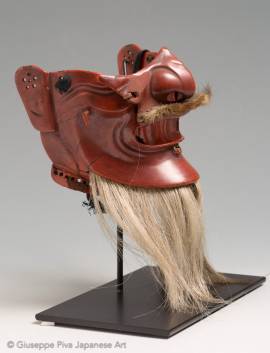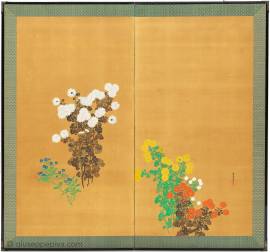Mid Edo period, 18th centuryAlthough it has not been possible to identify exactly the armor’s provenance, stylistic analysis suggests a link to the Kuroda clan, whose armor shares many similarities with this one. The choice of a momonari kabuto, a peach-shaped helmet popular among Kuroda clan samurai, is the most visible characteristic, but the really noteworthy element, distinctive to this family's armor, is the typical twin fukigaeshi on the sides of the kabuto, made of kozane plates on an egawa surface (printed leather). This link would also be confirmed by the fuji kamon (family...
WORKS FOR SALE
Okina menpoMid Edo Period (1615-1867Red lacquered samurai armor's mask A red lcquered high level mask, finely embossed with wrinkles all over the face. The mouth is wide open and the long beard resemble those of on aged man.
Two-fold screenInk, pigments and gofun on gilt silk.Signed: Sekka Hitsu with seal YoshitakaCirca 1920-40189 by 177,5 cm The screen depicts three varieties of chrysanthemums. Symbol of the imperial court, the chrysanthemum represents longevity and goodwill. Because of its auspicious meaning, the flower frequently appears on Japanese artworks of every kind.Painter and designer, Kamisaka Sekka has been one of the most important Japanese artist who brought the traditional aesthetic in western world. Sekka came from a samurai family - his father was in service at the imperial palace in Kyoto...
Copyright © 2016 - giuseppe piva - VAT: 05104180962










